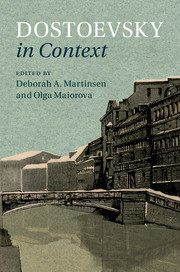Book contents
- Frontmatter
- Contents
- List of illustrations
- Notes on contributors
- Acknowledgments
- Note on citation, transliteration, glossary, and dates
- Chronology
- 1 Introduction: the many worlds of Dostoevsky
- PART I SOCIAL, HISTORICAL, AND CULTURAL CONTEXTS
- i CHANGING POLITICAL, ECONOMIC, AND SOCIAL LANDSCAPE
- ii POLITICAL, SOCIAL, AND CULTURAL INSTITUTIONS
- iii SPACE AND PLACE
- 18 Symbolic geography
- 19 St. Petersburg
- 20 The Crystal Palace
- iv RELIGION AND MODERNITY
- PART II LITERATURE, JOURNALISM, AND LANGUAGES
- Glossary
- Further reading
- Index
- References
18 - Symbolic geography
from iii - SPACE AND PLACE
Published online by Cambridge University Press: 18 December 2015
- Frontmatter
- Contents
- List of illustrations
- Notes on contributors
- Acknowledgments
- Note on citation, transliteration, glossary, and dates
- Chronology
- 1 Introduction: the many worlds of Dostoevsky
- PART I SOCIAL, HISTORICAL, AND CULTURAL CONTEXTS
- i CHANGING POLITICAL, ECONOMIC, AND SOCIAL LANDSCAPE
- ii POLITICAL, SOCIAL, AND CULTURAL INSTITUTIONS
- iii SPACE AND PLACE
- 18 Symbolic geography
- 19 St. Petersburg
- 20 The Crystal Palace
- iv RELIGION AND MODERNITY
- PART II LITERATURE, JOURNALISM, AND LANGUAGES
- Glossary
- Further reading
- Index
- References
Summary
“All these new ideas, reforms, and theories – it's all reached us out in the provinces, but to see everything and see it clearly, one must be in Petersburg”: thus does a character in Crime and Punishment (1866) explain what he hopes to gain from coming to the capital (6:115; Pt. 2, Ch. 5). And judging from Dostoevsky's own career, the author might well have concurred, for as much as Dostoevsky professed his love for the common people or hinted at the spiritual riches buried in the Russian countryside, he showed little inclination to remove himself from the center, that is, from St. Petersburg. Not only was the capital the seat of print culture and state power, it also seems to have struck Dostoevsky as the only point of view from which one might “see everything and see it clearly.” This attachment to the capital resulted not simply from the writer's personal inclinations, but rather from the particular relationship between center and periphery, capital and province, that obtained in Russian culture. The symbolic binary (center/periphery) maintained its power throughout the nineteenth century despite the fact that Russia actually had two capitals: after Peter the Great (1682–1725) moved the seat of government from Moscow to Petersburg in 1712, Moscow continued to be seen as a cultural and spiritual center and thus a capital in its own right.
Over the course of the nineteenth century, and especially during Dostoevsky's lifetime, provincial Russia was transformed. By the 1830s, transportation networks were growing, social mobility was slowly increasing, and more printed texts were beginning to circulate beyond Petersburg and Moscow. By mid-century, the traditional gentry's cultural influence was in decline and new intellectuals of non-noble origin were contributing more and more to public life, especially through journalism. After the debacle of the Crimean War (1853–6), the state turned its attention to modernization efforts, assuming (incorrectly) that much-needed economic and industrial reforms could be undertaken without triggering significant political or social change. The Great Reforms of the 1860s initiated truly radical transformations: the serfs were emancipated, the judicial and educational systems were restructured, censorship was relaxed, and zemstva* were established. By the 1870s, railroad networks were growing fast and an urban working class was taking shape. Literacy rates were rising steadily. Arguably, such changes had at least as much impact on provincial life as they did on the capitals.
- Type
- Chapter
- Information
- Dostoevsky in Context , pp. 159 - 167Publisher: Cambridge University PressPrint publication year: 2016



